![]()
Aroids and other genera in the Collection
Take the Tour Now?
Orchids
The
Exotic Rainforest
Plants in
the Exotic Rainforest Collection
The images on this website are copyright protected. Please contact us before any reuse.
In depth information on how to grow Philodendron species, Click this Link
Within our collection we have many species of Philodendron. If you are seeking other photos, click this link
Sold as
Philodendron corrugatum Croat
The specimen in our photos is highly likely to be
Philodendron albovirescens
Sodiro ex Croat
and not Philodendron corrugatum
Neither species has yet to be published to science and
both are being further studied
by Dr. Croat.
As a result neither is italicized.
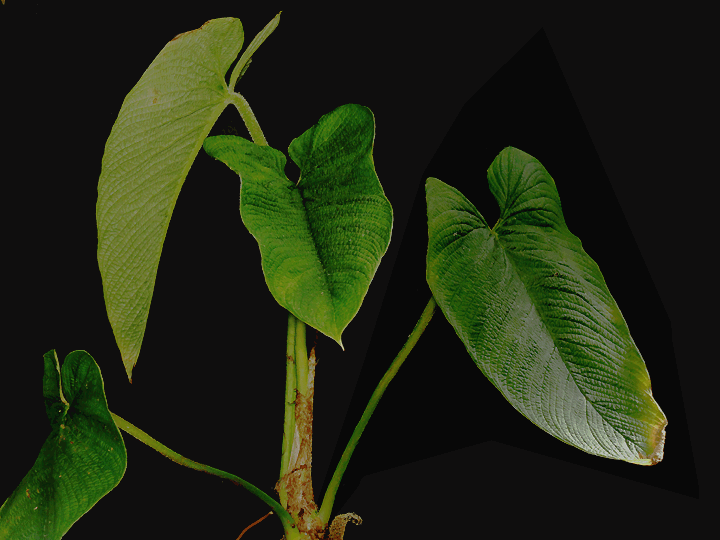
The specimen in our photos is
likely Philodendron albovirescens
Sodiro ex Croat
and not Philodendron corrugatum
Philodendron
albovirescens
is native to the northern and northwestern
portions of Ecuador and the western portion of Colombia at
elevations ranging from 600 to 1325 meters (1,970 to 4,350 feet).
P. albovirescens has
been collected near Chocó and Narino in Colombia but also
collected in the country of
Ecuador. According to the collection data listed on
TROPICOS in Ecuador the species has been collected near
Esmeraldas which is
near the Pacific Ocean in northwestern Ecuador. The
species has also been collected near Esmeraldas San Lorenzo west
of Lita as well
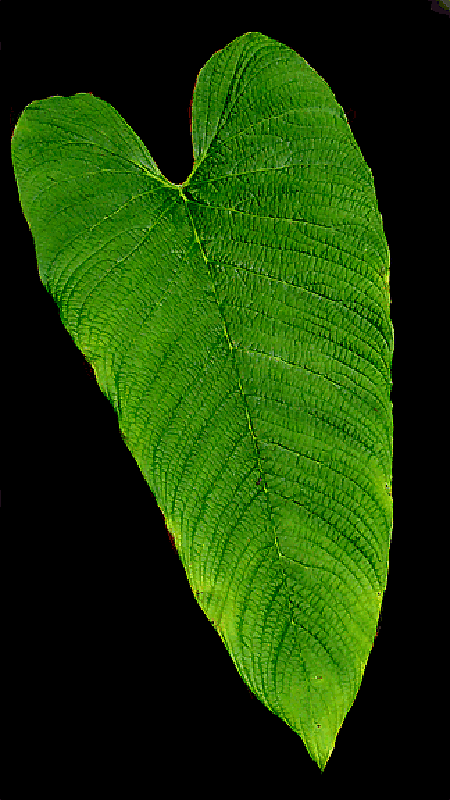 as
collected fairly near Lita in Esmeraldas Province on the western
slope of the
Andes.
In addition, the species has also been collected near Carchi
which is east of Lita All these locations are near the border
with Colombia. TROPICOS is a service of the Missouri
Botanical Garden and can be found at
http://www.tropicos.org/
You can view collection data notes by going to the
species name, selecting "specimens" at the top of the page, and
reading all the information found by clicking the specimen
number to the right of the page.
as
collected fairly near Lita in Esmeraldas Province on the western
slope of the
Andes.
In addition, the species has also been collected near Carchi
which is east of Lita All these locations are near the border
with Colombia. TROPICOS is a service of the Missouri
Botanical Garden and can be found at
http://www.tropicos.org/
You can view collection data notes by going to the
species name, selecting "specimens" at the top of the page, and
reading all the information found by clicking the specimen
number to the right of the page.
The first known collection of P. albovirescens was many years ago by Jesuit priest Luis Sodiro. Sodiro served in Ecuador in the late 1800's through the turn of the 20th century and described 281 taxa of Ecuadorian Araceae, mostly Anthurium species. As a result, Dr. Croat used the name Philodendron albovirescens Sodiro ex Croat since the name was an unpublished name originally credited to Sodiro.
The
best information available indicates Philodendron albovirescens
was first collected in modern times in the early 1980's by
several collectors. The highly respected late Lynn
Hannon who is renowned as a self taught taxonomy expert and
other well known collectors again collected P. albovirescens in
the mid 1990's.
Philodendron corrugatum (which is a totally different species
with the same general appearance) is endemic or exclusively found
in Colombia in the northwest corner as well as the western side
of that South American country down to near the
western border
with Ecuador. According to collection data listed on
TROPICOS,
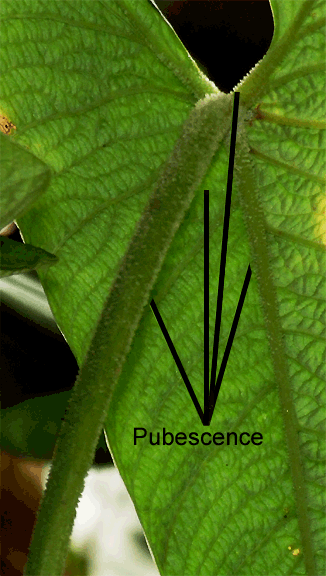 specimens of Philodendron corrugatum have been
collected in the vicinity of Chocó, in the Parque Nacional
Natural "Las
Orquideas", in Antioquia, Urrao northwest of Medillin, near Jose
del Palmar which is northwest of Bogota and near Risaralda,
Mistrato as well as Valle del Cauca in southwestern Colombia,
All these regions are in either the northwest area of Colombia somewhat near the
border with Panama or southwest portions of Colombia and
nearer the Pacific Ocean. Philodendron corrugatum
been found relatively near the border with Ecuador. The
species is found at elevations ranging from 600 to 1550 meters
(1,970 to 5,085 feet).
specimens of Philodendron corrugatum have been
collected in the vicinity of Chocó, in the Parque Nacional
Natural "Las
Orquideas", in Antioquia, Urrao northwest of Medillin, near Jose
del Palmar which is northwest of Bogota and near Risaralda,
Mistrato as well as Valle del Cauca in southwestern Colombia,
All these regions are in either the northwest area of Colombia somewhat near the
border with Panama or southwest portions of Colombia and
nearer the Pacific Ocean. Philodendron corrugatum
been found relatively near the border with Ecuador. The
species is found at elevations ranging from 600 to 1550 meters
(1,970 to 5,085 feet).
Although
sometimes available to collectors, neither Philodendron
albovirescens nor Philodendron corrugatum have yet to be
officially published to science despite
at least one notation on the internet
stating
that both species were published in 1997. This personal
message from aroid botanist Dr. Thomas B. Croat Ph.D., P.A.
Schulze Curator of Botany
of the Missouri
Botanical Garden in St. Louis, MO. received in January, 2008
explains:
"the species is not yet described and there are a mess of
species to
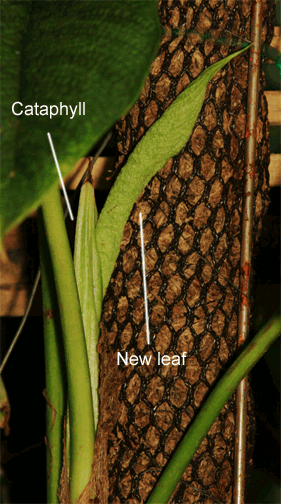 consider first. I was working on a revision of that
group with Marcela Mora before she left here for
graduate school. I do not think that P.
corrugatum occurs in
consider first. I was working on a revision of that
group with Marcela Mora before she left here for
graduate school. I do not think that P.
corrugatum occurs in
Interestingly, our specimen was reportedly collected in Ecuador. In one of his personal notes Dr. Croat indicated the leaf blades of Philodendron albovirescens have cross veins which are moderately weak and irregularly spaced as well as not strictly parallel. He also indicated the veins are closely and often irregularly spaced. As a result there is now a great deal of doubt our specimen is truly Philodendron corrugatum even though it was exported directly from Ecuador and was sold with a tag stating the plant was in fact Philodendron corrugatum. Instead, our specimen is likely a related species within the complex known as Philodendron albovirescens due to specific characteristics which do not match well to Dr. Croat's published field notes of P. corrugatum. The differences include narrowly canaliculate (canal-like or "C" shaped) petioles as well as what appears to be pubescence (hair) on the petiole near the apex as well as the mid and basal ribs near the sinus. The color of the cataphyll and other differences also appear to be apparent but may be explainable due to the age of the cataphyll. These differences do appear to match well to the known characteristics of Philodendron albovirescens.
As
Dr. Croat stated,
there are apparently at least four species
(possibly five) that appear similar in form and as a result are
in the same complex. Based on information from a knowledgeable
collector who has personally observed these
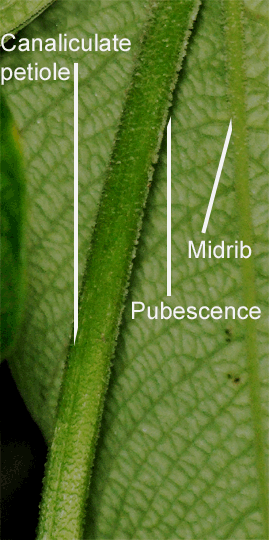 specimens in
Ecuador, at one time two
similar species grew together along the first part of the road that
originally was used as the Lita to San Lorenzo road.
Philodendron
albovirescens was
apparently not observed anywhere else in the area and
is likely very limited in distribution. It is now highly
doubtful many specimens remain along this road because the area
has been somewhat destroyed and experts familiar with the area
indicate the road is almost impassable. One of the two
species that were similar was also less rugose having fewer
coarse reticulated lines. Lita is south of the border with
Colombia and northwest of Quito while San Lorenzo is west of
Lita.
specimens in
Ecuador, at one time two
similar species grew together along the first part of the road that
originally was used as the Lita to San Lorenzo road.
Philodendron
albovirescens was
apparently not observed anywhere else in the area and
is likely very limited in distribution. It is now highly
doubtful many specimens remain along this road because the area
has been somewhat destroyed and experts familiar with the area
indicate the road is almost impassable. One of the two
species that were similar was also less rugose having fewer
coarse reticulated lines. Lita is south of the border with
Colombia and northwest of Quito while San Lorenzo is west of
Lita.
As a result, I now believe the plant in our collection likely originated from the Lita area and is the specimen in this complex known as Philodendron albovirescens Sodiro ex Croat. My primary reason for this belief is none of the other species in the complex posses the majority of those characteristic. Dr. Croat has reviewed our photos and has determined it is not P. corrugatum and is very likely P. albovirescens.
Philodendron
albovirescens grows as a terrestrial species as well as a
hemiepiphyte (hem-a-EPA-fit) while
Philodendron corrugatum grows both as an epiphyte (ep-a-FIT) and a
terrestrial species. A
hemiepiphyte
is a species that may begin life as either a terrestrial or
epiphytic species and either climb a host tree or grow downwards
to set root in the soil. An epiphyte is a plant that does
not necessarily grow on the ground while it both climbs and
grows upon another plant, normally a tree. An epiphyte is
capable of never having its roots reach soil since the seeds are
placed on the branches of
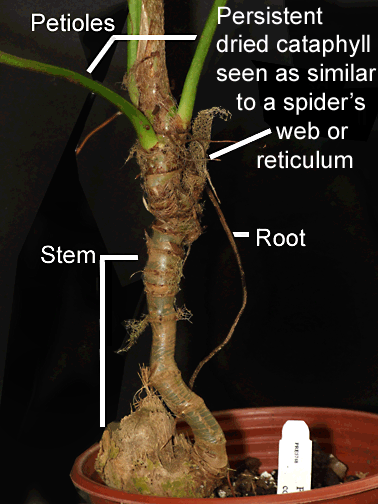 a tree in the droppings of a bird or
animal that has eaten the fruit of a species.
a tree in the droppings of a bird or
animal that has eaten the fruit of a species.
The leaf blades of both species are subcoriaceous (thin) and the blades are matte in appearance as well as dark green on the adaxial or upper blade surface. With rugose venation (veins), the blades of each possess a rough wrinkled surface with coarse reticulated lines easily observed. On our specimen the adaxial (upper) surface is somewhat bicolorous (two colored). The venation (vein structure) is extremely reticulate and the primaries are not perfectly parallel as well as somewhat wavy which makes it strange in the genus Philodendron. Philodendron species should have primary veins that are parallel. On page 169 of the scientific text The Genera of Araceae by Mayo, Bogner and Boyce you can read this quote regarding the characteristics of the genus Philodendron: "primary lateral veins pinnate, rarely pedate. running into marginal vein, secondary lateral and higher venation parallel-pinnate, sometimes tertiaries and higher veins transversely reticulate between secondaries, sometimes all veins slender with no distinct primary laterals." The photos at the bottom of this page reveal that our specimen has primaries that are distinctly curved in opposing directions. You can view charts showing normal Philodendron venation on page 171, "C". In order to compare the venation of our specimen also see to the illustrations on page 168 "A" for Spathacarpa venation.
This unusual characteristic was brought to my attention by my close friend and aroid expert Julius Boos after his examination of the photos on this page. Since Philodendron albovirescens was collected, grown and closely examined by Lynn Hannon, Julius had the opportunity to see the specimen in her personal collection as well as in the collection of the late Dr. Monroe Birdsey. Both Lynn and Dr. Birdsey brought the unusual venation to Julius' attention and were surprised to find this unusual characteristic on the specimen.
All
the leaf veins of both species are prominently sunken on the
upper surface but raised on
the abaxial (underside).
The
smaller veins on the underside are both prominent and
perpendicular to the major veins within P. corrugatum.
However,
the minor
veins of our plant do not always appear to run perpendicular to
the primaries and are at least somewhat irregular
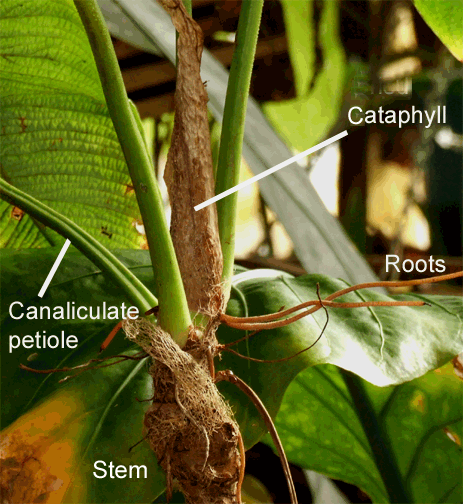 and curved. See the
extreme close-up photos at the bottom of this page for a
detailed view.
and curved. See the
extreme close-up photos at the bottom of this page for a
detailed view.
The petioles of
Philodendron corrugatum, which connect the stem to the leaf
blade, are terete (round) with many pale short lines along the
axis appearing as pale streaks and similar in appearance to
broken striation. However, in our specimen of what appears
to be Philodendron albovirescens the petioles
are firm and are canaliculate ("C" shaped) on the adaxial
(upper) surface for approximately the lower 2/3 rd's of the
petiole's stalk. In addition there is pubescence (hair) on
the upper 1/3 of the petiole which is not observed on
Philodendron corrugatum. The upper 1/3 of most petioles of
our specimen appear to be more or less terete. The
pubescence can also be seen on the upper mid rib and upper basal
ribs of the blade but they do possess the
broken striation. See
both photo right, above right and at the bottom of this
page for
a more detailed view. The broken lines can be observed on
both species.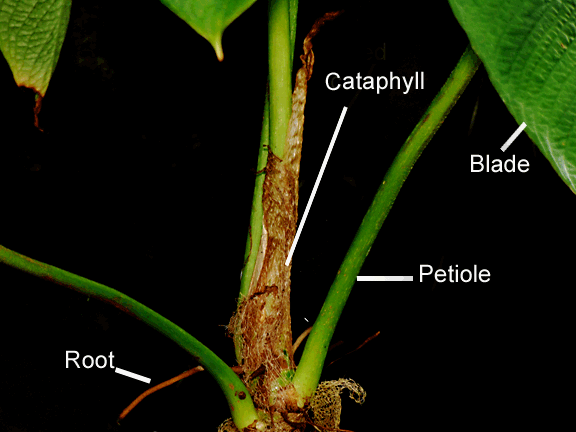
The stems of our plant
measure up to approximately 4 cm in diameter and the internodes
measure approximately
2 to 3 cm long.
The first measurement is slightly higher than published by Dr.
Croat for Philodendron corrugatum. An internode is a
segment of the stem between two nodes while the nodes are where
leaves may emerge. In botany the stem is not the support
for a leaf as is often thought by collector/growers but
instead is the base of the plant. The petioles which
support the leaves are stalk-like and grow from nodes along the
stem's
length.
The internodes, which are the stem segments between two nodes,
separate the nodes. Detailed photos can be seen at the
right, above and at the left, below.
In Philodendron corrugatum
the cataphylls which are a modified leaf that surrounds
each new leaf as it
emerges are green
in color as well as
weakly 2
ribbed. On our
specimen the cataphyll is
currently bicolorous
with brown and tan. That may
be due to the
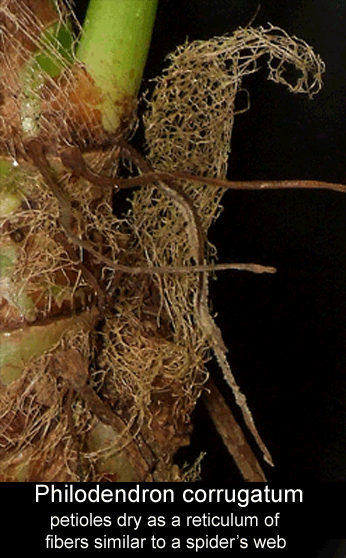 fact
our current cataphyll has already begun the process of drying
since as the cataphyll dies it dries to fibrous materials which
are persistent (remaining) on the specimen turning both light brown and
becoming a fine net-like
reticulum of fibers similar in shape to a spider's web.
That reticulum of fibers can be observed on
both Philodendron corrugatum
and Philodendron albovirescens (see photo, left).
fact
our current cataphyll has already begun the process of drying
since as the cataphyll dies it dries to fibrous materials which
are persistent (remaining) on the specimen turning both light brown and
becoming a fine net-like
reticulum of fibers similar in shape to a spider's web.
That reticulum of fibers can be observed on
both Philodendron corrugatum
and Philodendron albovirescens (see photo, left).
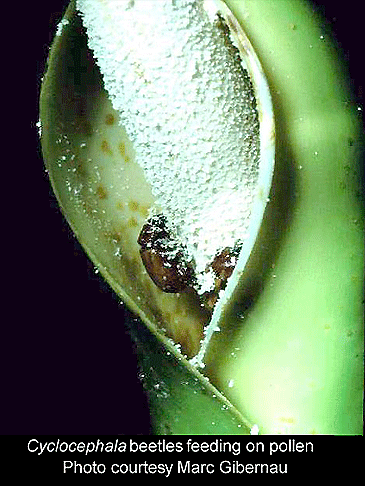 All
Philodendron species are aroids. An aroid is member of the
larger family Araceae and is a plant that
reproduces by producing
an inflorescence known
to science
as a spathe and spadix. Most
people believe the
spathe is a "flower"
which it is not. The spathe is a specially
modified leaf whose purpose
is to protect the spadix at the center of the spathe. On the
spadix there can be
found very tiny male, female
and sterile male flowers when the plant is at sexual
anthesis. When ready to reproduce, the male flowers produce
pollen and the female flowers are receptive to the pollen from
another specimen of the same species also at male anthesis.
The sterile flowers produce a scent known as a pheromone and the
male flowers provide food in the form of a protein found in the
pollen. Both of these work together to attract a
pollinating insect. The pollinating insect, which is almost always a
beetle from the genus Cyclocephala, eats the pollen and
uses the spathe as a form of warmth and protection from the cool
forest nights. Although the photo (right) illustrates
Cyclocephala beetles eating pollen on a Philodendron, the
specimen shown is not the spathe and spadix of either
Philodendron albovirescens nor Philodendron corrugatum.
All
Philodendron species are aroids. An aroid is member of the
larger family Araceae and is a plant that
reproduces by producing
an inflorescence known
to science
as a spathe and spadix. Most
people believe the
spathe is a "flower"
which it is not. The spathe is a specially
modified leaf whose purpose
is to protect the spadix at the center of the spathe. On the
spadix there can be
found very tiny male, female
and sterile male flowers when the plant is at sexual
anthesis. When ready to reproduce, the male flowers produce
pollen and the female flowers are receptive to the pollen from
another specimen of the same species also at male anthesis.
The sterile flowers produce a scent known as a pheromone and the
male flowers provide food in the form of a protein found in the
pollen. Both of these work together to attract a
pollinating insect. The pollinating insect, which is almost always a
beetle from the genus Cyclocephala, eats the pollen and
uses the spathe as a form of warmth and protection from the cool
forest nights. Although the photo (right) illustrates
Cyclocephala beetles eating pollen on a Philodendron, the
specimen shown is not the spathe and spadix of either
Philodendron albovirescens nor Philodendron corrugatum.
In addition to the pheromones the beetle is apparently attracted
to the inflorescence by a bright "glow" visible to the beetle's
antennae or some unknown sensor on its body (but not the eyes) as a result of the infrared
heat produced during anthesis which causes the temperature of
the spathe and spadix to increase significantly during sexual
anthesis. Infrared heat is not visible to the human
eye but is easily visible to many insects. The
infrared heat can easily be felt on the open palm of your hand
if held at close range to the spathe during anthesis. Once the
female flowers are pollinated by the beetle carrying pollen on
its legs and body from another plant of the same species the Philodendron
will produce berries containing seeds The inflorescence of
Philodendron corrugatum has a spathe that is green to cream
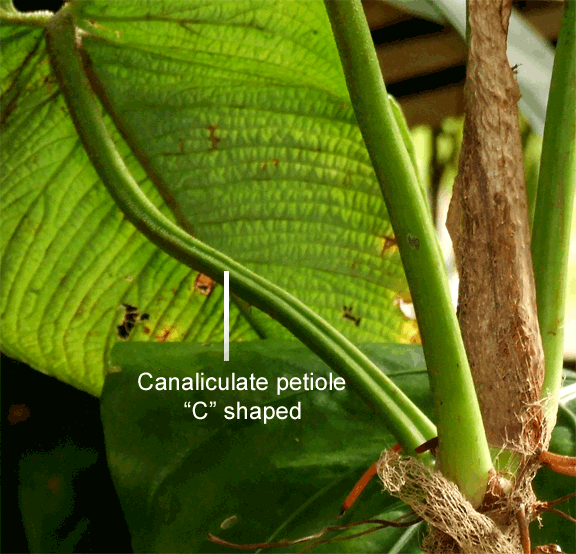 on
the outer surface but is red inside the spathe's tube with pink
inside at places. The
on
the outer surface but is red inside the spathe's tube with pink
inside at places. The
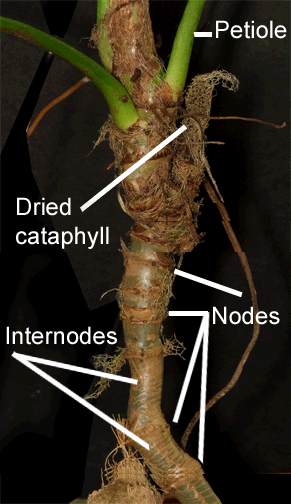 spadix
is pale yellow. No information is currently available
regarding the coloration of the spathe of Philodendron
albovirescens. As yet no inflorescence has not been observed
on our specimen.
spadix
is pale yellow. No information is currently available
regarding the coloration of the spathe of Philodendron
albovirescens. As yet no inflorescence has not been observed
on our specimen.
For a more through explanation of the sexual reproduction of aroid species read this link: http://www.exoticrainforest.com/Natural%20and%20artificial%20pollination%20in%20aroids.html
At present, we are striving to collect additional data for Philodendron albovirescens Sodiro ex Croat as well as Philodendron corrugatum Croat in an effort to further update the information on both species.
Dr. Croat has indicated our specimen is very likely Philodendron albovirescens.
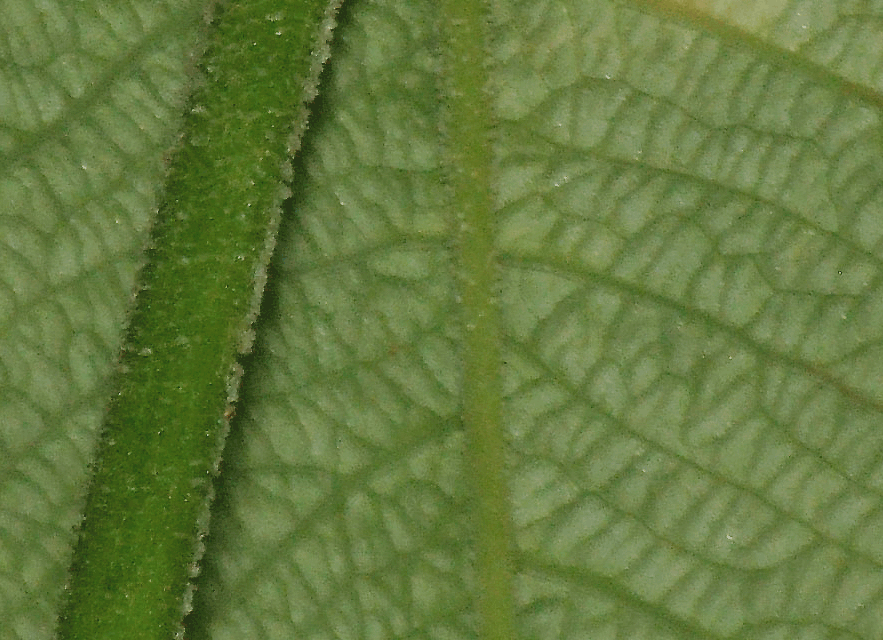
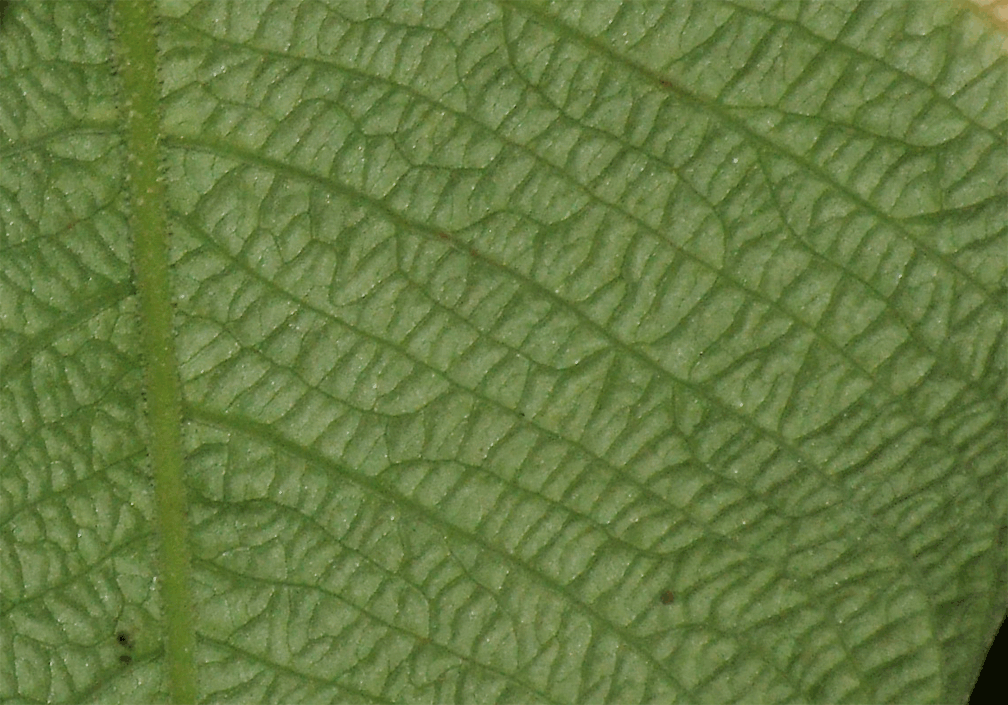
Want to learn more about aroids?
Join the International Aroid Society:
http://www.exoticrainforest.com/Join%20IAS.html